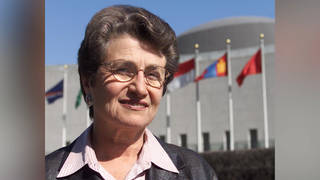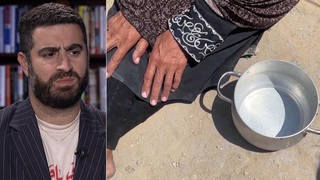
A new report on Gaza’s escalating health crisis projects that due to the extent of destruction wrought upon the region’s infrastructure since October, thousands of Palestinians will continue to die from disease, malnutrition, dehydration and starvation, regardless of whether Israel continues to pursue its military assault. “In case of an escalation, we’d see around 85,000 deaths,” warns Zeina Jamaluddine, a nutritionist and epidemiologist who is one of the lead authors of “Crisis in Gaza: Scenario-Based Health Impact Projections” from the London School of Hygiene and Johns Hopkins University. Jamaluddine also says it is not too late to stop the bulk of these forecasted deaths, should a ceasefire be immediately put into place and aid deliveries resumed. “In case of a ceasefire now, we would be saving around 75,000 lives.”
Transcript
AMY GOODMAN: This is Democracy Now! I’m Amy Goodman.
We turn now to damning new projections about the health crisis unfolding in Gaza. In a minute, we’ll be joined by one of the lead authors of a joint report from the London School of Hygiene and Johns Hopkins University which found, quote, “even in the best-case ceasefire scenario, thousands of excess deaths would continue to occur, mainly due to the time it would take to improve water, sanitation and shelter conditions, reduce malnutrition, and restore functioning healthcare services in Gaza,” unquote.
In an interview with CNN last week, the regional emergency director of the World Health Organization, Dr. Richard Brennan, was asked about the report’s projections.
DR. RICHARD BRENNAN: This study is absolutely striking. I don’t know how many wake-up calls we need to alert us to the dire, absolutely dire, and desperate situation on the ground. We have already lost 29,000 people from traumatic injuries. We already have over 70,000 others that have survived injuries, with some terrible injuries. I was in Gaza last week. You can’t imagine the deformities, the limb losses of young children, young adolescents, young adults, who are going to be left with these disabilities for years to come. We don’t know how many people have died because they didn’t get access to their blood pressure medicines or their diabetic treatment and so on. But we know — we suspect that thousands more have died unnecessarily because of lack of access to healthcare.
And now you have these two reputable institutions. I know the two study leaders. No one is better placed to do these kind of estimates than these two institutions. And now we’re saying if things continue, if we see this escalation, if we see this military operation into Rafah, we’re going to be looking at an extra 80-odd thousand deaths in six months’ time. If that’s not a wake-up call, I don’t know what is.
AMY GOODMAN: That was the World Health Organization’s regional emergency director, Dr. Richard Brennan.
For more, we’re joined in London by Zeina Jamaluddine. She’s a nutritionist, an epidemiologist, one of the lead authors of this new joint report from the London School of Hygiene and Johns Hopkins titled “Crisis in Gaza: Scenario-Based Health Impact Projections.” She’s a research fellow at the London School of Hygiene and Tropical Medicine.
Zeina, welcome to Democracy Now! Thanks so much for joining us. Just lay out your findings.
ZEINA JAMALUDDINE: Hello. Welcome.
So, as that was just mentioned, in fact, we have attempted to actually project what would be the excess mortality in different scenarios in Gaza. In fact, we know that there is the direct effect of the war, but, however, we also wanted to understand what is the indirect effect of the war on infectious diseases, for example, mortality, from COVID-19, increased excess mortality from maternal and newborn healthcare because they’re not able to access health services, increased mortality due to the chronic diseases for specifically Type 1 diabetic patients, people with chronic kidney diseases, and how much excess mortality would happen due to this. We also modeled the impact of acute malnutrition, which is what was just mentioned right now in terms of how much wasting or thin children would increase as an underlying factor to all of this excess death.
So, with this attempt, we actually find that in case of a ceasefire, around 6,000 to 11,000 lives would actually be dead, and would have an excess death in the case of a ceasefire of around 11,000 deaths. In case of an escalation, we’d see around 85,000 deaths, which is currently what’s happening in Rafah, in the next six months. But also, what’s important to point out is, in case of a ceasefire now, we would be saving around 75,000 lives.
AMY GOODMAN: Can you respond to this latest news of the 2-month-old baby boy, the Palestinian child, who died on Friday of starvation?
ZEINA JAMALUDDINE: Yes, of course. So, basically, before the war, we know that in terms of wasting, which means the thin children, the prevalence or the level in Gaza was around 3%. The majority of the population in Gaza was heavily reliant on food assistance. This was 77% of the population relied on assistance coming in. With the current food trucks being very limited coming into Gaza, we actually modeled the decrease in the food availability currently in Gaza, the decrease in agricultural land available in Gaza, but also the decrease in the food trucks coming into Gaza, to actually understand what is the caloric intake that is happening currently, to understand the increase in malnutrition or wasting.
What we project, in fact, is that, to date, we see a prevalence of around 12% of children under 5 that are wasting. We would also project that in next few months, in the case of an escalation, this would reach to 26%, which is classified as catastrophic. In the next six months, the prevalence would reach 50%. So, basically, responding to what you’re saying, we’re actually currently starting to see the critical phase of acute malnutrition being portrayed.
AMY GOODMAN: What would solve this, Zeina?
ZEINA JAMALUDDINE: A ceasefire, first of all. A significant increase in food access, whether it’s also through airdrops and through, basically, allowing all the food trucks and also medical aid to come in, without any restrictions.
AMY GOODMAN: I wanted to ask you about how casualties are prefaced, especially in the Western media. Your piece for The Lancet in November is titled “Excess mortality in Gaza: Oct 7-26, 2023.” So many news media in the West preface casualty figures by saying, quote, “According to the Gaza Health Ministry, which is run by Hamas,” which has led so many to question the veracity of the figures. What did you find?
ZEINA JAMALUDDINE: So, when the Ministry of Health has released the first listing of people who were killed during October, we, as epidemiologists, took this data and actually analyzed to understand what is happening in terms of duplication and the accuracy of the data. We have analyzed it as London School separately, but also Hopkins University has analyzed it. And we both find that there is no reason to actually doubt the accuracy of this data. There’s another aspect of it all to say that in previous war, the Ministry of Health data has been validated, basically, from different independent sources. At the same time, this is the same system that the Ministry of Health has used previously for COVID-19 reporting or other mortality estimation and reporting. So, it’s important to note that this didn’t start at the beginning of the war of reporting mortality, and so they relied on this system. But we did assess the accuracy, and we find no reason to doubt these data sets or the numbers reported by the Ministry of Health.
AMY GOODMAN: Well, Zeina Jamaluddine, we want to thank you so much for being with us, nutritionist and epidemiologist, one of the lead authors of the new joint report from the London School of Hygiene and Johns Hopkins titled “Crisis in Gaza: Scenario-Based Health Impact Projections.” She’s a research fellow at London School of Hygiene and Tropical Medicine. We’ll link to that report.
Next up, “Anti-Palestinian at the Core.” We look at the origins and growing dangers of U.S. anti-terrorism law. Stay with us.












Media Options